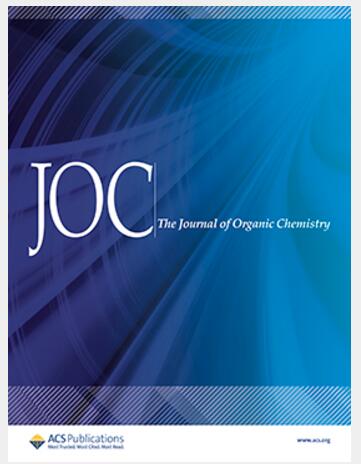Toward a Systematics for the Lowest Excited States of Heteroaromatics Enabled via Cyclic π-Conjugated Carbenes and Heteroelement Analogues.
IF 3.6
2区 化学
Q1 CHEMISTRY, ORGANIC
引用次数: 0
Abstract
The photochemistry of heteroaromatic compounds depends on the character of their lowest electronically excited states, which are of either n,π* or π,π* type. For species with 4n + 2 π-electrons, the latter type of states can be antiaromatic to various extents according to Baird's rule and, thus, highly reactive. The n,π* type of states, on the other hand, will have an odd number of π-electrons leading to an unclear character, spanning from aromatic to antiaromatic. Six-membered ring (6-MR) heteroaromatics with in-plane lone-pair orbitals (nσ, herein n) have either n,π* or π,π* states as their lowest vertically excited states, but regular five-membered ring (5-MR) heteroaromatics with one or two N, O, and/or S atoms never have n,π* states as these states. However, this is different for cyclic π-conjugated (potentially aromatic) 5-MR carbenes that have the n orbitals at the divalent C atom. Also, 3-MR species have n,π* states as their lowest vertically excited states. Herein, we reveal which factors determine which type of vertical excited state is the lowest in energy for various heteroaromatics. The important factors are (i) the electronegativity of the heteroatom(s), (ii) the valence angle at the heteroatom impacting the lone-pair orbital energy, (iii) the number of π-orbitals and π-electrons, (iv) the degree of (anti)aromatic character of the n,π* state, (v) the electronegativity of atoms adjacent to the heteroatom, and (vi) the spatial extent of the n orbital affecting the intraorbital electron repulsion. Our findings point toward the development of a rational systematics for prediction of which heteroaromatics have n,π* as the first vertical excited states and which ones have π,π* states as these.环π共轭卡贝烯和杂元素类似物使杂芳烃最低激发态的系统研究。
杂芳香族化合物的光化学性质取决于其最低电子激发态的性质,它们是n,π*型或π,π*型。对于具有4n + 2 π电子的物质,根据Baird规则,后一种状态可以不同程度地反芳,因此反应性很强。另一方面,n,π*型的态,π电子数为奇数,导致从芳香族到反芳香族的特征不明确。具有平面内孤对轨道(nσ,这里是n)的六元环(6-MR)杂芳香化合物的最低垂直激发态为n,π*或π,π*,而具有一个或两个n, O和/或S原子的规则五元环(5-MR)杂芳香化合物的最低垂直激发态则为n,π*。然而,对于在二价C原子上有n轨道的环π共轭(可能是芳香的)5-MR碳烯来说,这是不同的。同时,3-MR物质的最低垂直激发态为n,π*态。在此,我们揭示了哪些因素决定了哪种类型的垂直激发态是能量最低的各种杂芳烃。重要的影响因素有:(1)杂原子的电负性,(2)杂原子上的价角对孤对轨道能量的影响,(3)π轨道和π电子的数目,(4)n,π*态的(反)芳香性程度,(5)杂原子相邻原子的电负性,(6)n轨道的空间范围对轨道内电子斥力的影响。我们的发现为预测哪些杂芳烃以n,π*为第一垂直激发态以及哪些以π,π*为第一垂直激发态提供了一个合理的系统。
本文章由计算机程序翻译,如有差异,请以英文原文为准。
求助全文
约1分钟内获得全文
求助全文
来源期刊

Journal of Organic Chemistry
化学-有机化学
CiteScore
6.20
自引率
11.10%
发文量
1467
审稿时长
2 months
期刊介绍:
Journal of Organic Chemistry welcomes original contributions of fundamental research in all branches of the theory and practice of organic chemistry. In selecting manuscripts for publication, the editors place emphasis on the quality and novelty of the work, as well as the breadth of interest to the organic chemistry community.
 求助内容:
求助内容: 应助结果提醒方式:
应助结果提醒方式:


